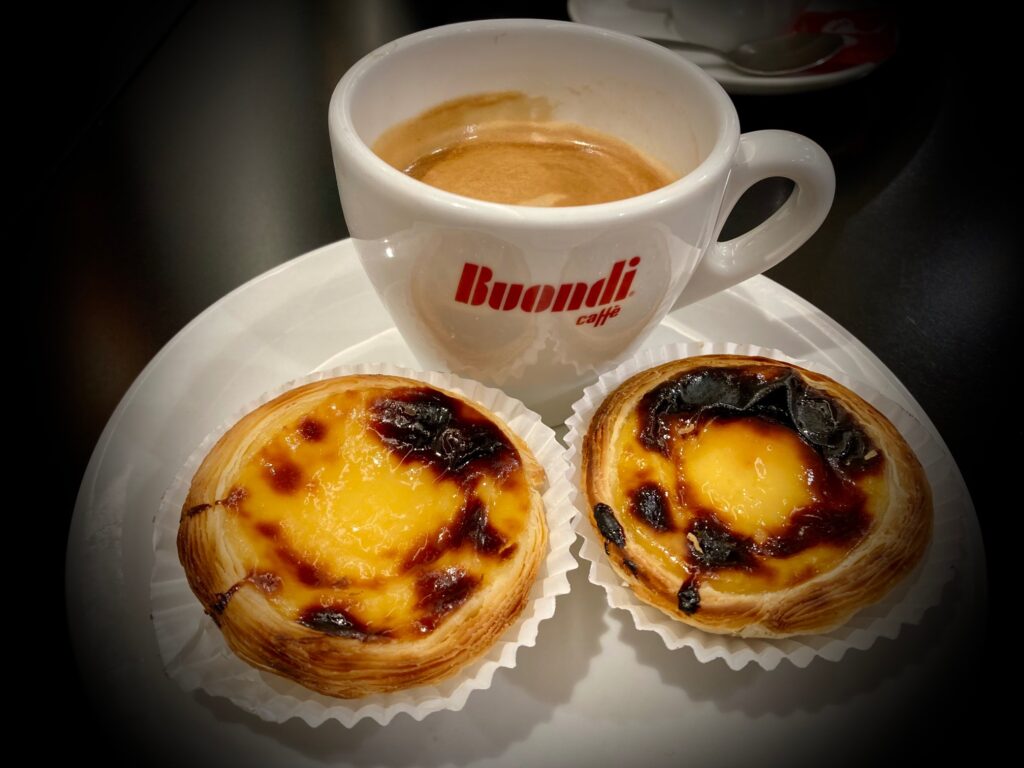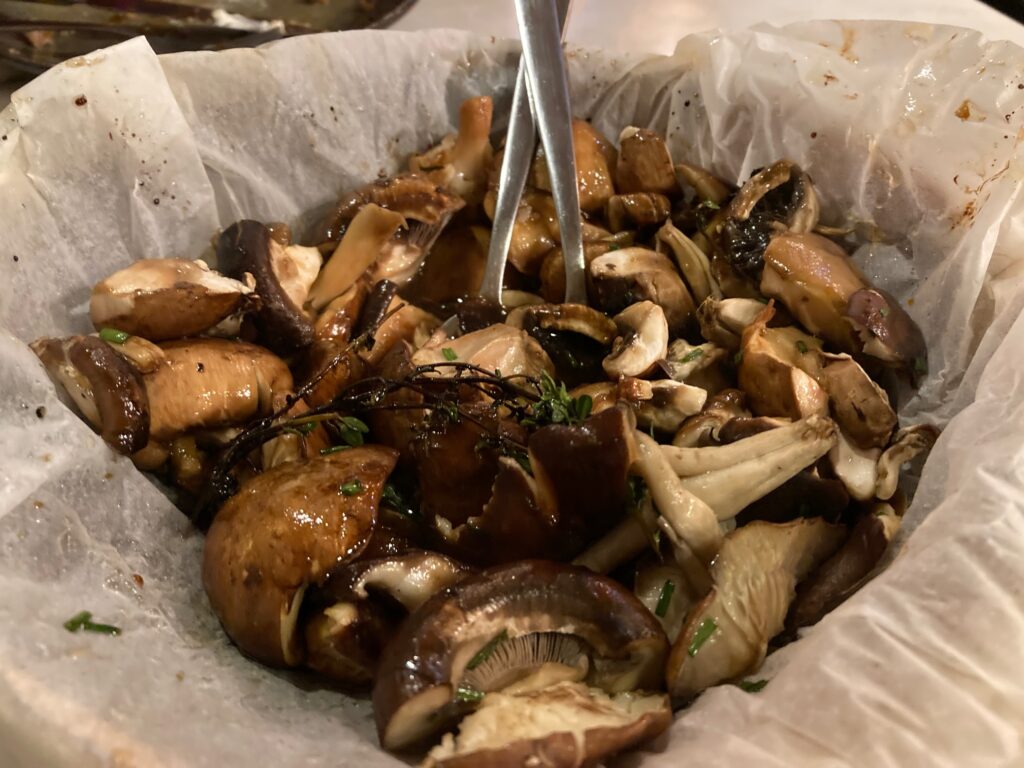The roots of Portuguese food lie in both native peasant cooking and ingredients obtained through trade routes established many centuries ago. Bread, rice, spices, pastries, sausages, and seafood remain the staples of many Portuguese meals.
While we were in Porto, we definitely tried some of their iconic dishes at a few of their popular restaurants. Overall, we opted to bypass the over-priced tourist restaurants and find some local places in our neighborhood. This enabled us to eat at great restaurants that offer local prices, daily specials on food and wine, and generally better food. And we did find some gems! One of the first things we learned about some of the restaurants here is that after you sit down for a meal, they automatically bring your table a basket of bread, a plate of olives, and a plate of cheese or salsicha (sausage). This is for you to nibble on while you wait for your order. If you eat it, you will be charged for it, it is not complimentary. If you don’t eat it, the waiter will take it away when your order comes out. This is common practice at most eateries across Portugal and Spain. This is good to know as your bill can add up very quickly if you’re not careful.
The food, beer, and wine in Porto was fantastic! As I previously stated in my tour blog,
the first order of the day was always to head down to our corner bakery, the Cafe Batalha. Get a table in the morning sun, and order a cafe duplo, or double espresso, along with a croissant, or some other delightful sweet or savory pastry. I can’t forget to mention the pastéis de nata. A three-bite egg custard tart dusted with cinnamon and mouth wateringly delicious. There seems to be a bakery on almost every block in the city, great for breakfast, lunch, or an afternoon coffee. Big breakfasts are not really a thing with the locals here. Unless we wanted a full breakfast, our morning coffees and pastries for two were less than $5.00. The waiter at our morning cafe soon knew us by site and would just give us a hand signal for the coffee, then take our food order when he brought our coffees out.


We had our first authentic Portugese meal the day after we arrived. We were in the historic old town on one of the side streets and decided to stop for lunch at a sidewalk cafe called Brasa Dos Leões. We were seated at a small outdoor table and the waiter brought out bread, chouriço, and olives that we munched on while we waited for our grilled sardines, batatas (potatoes), salad, and beer. The chourico and sardines were absolutely delicious, and we tried these at many different locations. This is when we found out that the side items brought to the table were not complimentary. But they were delicious and not very expensive. We were glad we ate them, but we knew what to look out for in the future.


We had lunch and afternoon coffee several times at a really nice bakery/restaurant called Confeitaria Tamisa. Located on the far upper edge of the historic zone, their sandwiches, salads, sausage and egg dishes, were all delicious. We also found their croissant de chocolate with a nice coffee to be heavenly and a great afternoon pick-me-up!

A couple of times we just stopped in the little local store near the park we liked to go to and bought fresh bread, olives, sausage, cheese, and a bottle of wine. All for only $10.00. The wine in the stores here is incredibly affordable and a picnic in the park on a sunny day is always fun.

Located in the neighborhood we were staying in was the Restaurante Baju. This is where we decided to try a sandwich Porto is famous for called the francesinha, which is a drowned sandwich. The sandwich is made with two thick slices of white bread, between goes wet-cured ham, a Portuguese sausage called linguiça, and either steak or roast beef. Then, the outside of the sandwich is covered with melted cheese, and lastly drowned in a special tomato and beer sauce. You can get a fried egg on top if you want as well. This was way to heavy for me to even come close to finishing, but it certainly was delicious. We ate dinner here several times because all their menu items were tasty and priced right. There were many restaurants located on these streets that surrounded Poveiros Square. We just happened upon this area while walking around our neighborhood. This area was quite a hike from the riverfront, but close to our Airbnb. So while it did have a few tourists like us wandering around, it was mainly locals eating here.


Another famous and local place in Poveiros Square is the Casa Guedes. They have three locations around the city. Here we had the best steak prego sandwich with carmelized onions, yummy! We also loved Portugals National Dish of bolinhas de bacalhau, or cod fish croquettes. We ate here at least three times.



Another Poveiros Square restaurant we liked is Trigo de Cantos. We loved ordering plates of their pimentos padrão, or grilled chili peppers to go along with their charcuterie board called a mistos which had a variety of cheese, olives, meats, and bread.


We found a great place, famous with the locals, called Conga. We got right in the first time we went, but the next time we had a bit of a wait. This place had a great bifana. Bifanas are traditional Portuguese sandwiches made with thin slices of pork that have been marinated in white wine, garlic, and paprika. They’re served on soft rolls with plenty of mustard and peri-peri sauce. I also loved their caldo verde soup, which is a creamy soup made with linguiça sausage, potatoes, and finely chopped kale. I had this with my bifana instead of fries. Their most popular dish that the locals crowded the place for was the papas de serrabulho. This is a traditional Portuguese stew that combines pork, chicken, salpicão and chouriço sausages, ham, corn flour, cumin, lemon, cloves, and nutmeg with pig blood. It looked great, and smelled great, but I couldn’t get past the pigs blood which turns the soup a very deep brownish red color. However, I do plan on trying it next time I’m there.

We visited another iconic little place called Gazela. This place is famous for it’s traditional Portuguese cachorrinho hotdog. A grilled pork sausage served on a thin, crispy bun. One of these with a cold beer goes down way to easy. This place was famous even before being featured on Anthony Bourdain some years ago. We ate here several times as it was also very affordable. We could each get a cachorrinho, fries, and a beer for around $15.00. Several places offer the cachorrinho done francesinha style with the cheese, sauce and egg.


We splurged on a fancy dinner one night at Rio Tapas & Bar. Aaron made reservations, but somehow we showed up the night before our reservation. We were all dressed up and everything. Oh well, we got to dress up two nights in a row as we went back the next night when our actual reservation was for. We tried a variety of tempting small plates! We had air bread with beef loin and foie gras. Next were goat cheese puffs with walnuts. Then some crispy shrimp. Next on order was wild mushrooms in parchment paper. Lastly, and one of our favorite dishes was broken egg. This dish consists of fried potatoes with prezunto (cured pork), topped with a sunny side egg broken open. I don’t know what they do to this simple sounding dish, but it is fantastic. All this, served with a nice bottle of red wine. It was marvelous! You have to make reservations as they only have eight tables, so you know the service is outstanding as well. This was an expensive meal, but it is worth treating yourself to one really outstanding dining experience when visiting Porto.





Walking across the Dom Luis Bridge to Gaia, we found restaurants lining the Douro river and looking back across to Porto. The first restaurant we tried in Gaia was the Casa Adao. Here we ordered the arroz caldoso, this is similar to a paella. The arroz caldoso was loaded with shrimp, had a rich broth, and came with bread. It is served in a large casserole dish and one order easily serves two people. This along with our drinks came to less than $20.00.

Our favorite restaurant in this area was the Taberinha do Manel. We ended up coming here twice, even though it was a little more than what we normally spend on a meal because the location, atmosphere, food, and staff were outstanding. Here we tried the braised beef cheeks stewed in port wine, the pica pau, which translates to woodpecker beef. It is a traditional snack often referred to as pecking food and eaten with a toothpick. We also had chouriço served with rye bread and goat butter, empanadas with iberian pig and serra de estrella cheese, beans and wild mushrooms stew, and the prezunto plate with artisan breads and olives. They had some really nice wines here as well. On our second visit, we happened to be seated by a couple from the U.S. who had recently moved to Porto and opened a wine export business. We chatted with them for a bit and while we were eating, they sent us over two really nice glasses of white wine. They’ve clearly been doing their research as this was one of the best white wines we had in Porto.


As far as beer and wine go. . . You don’t just order a beer, you order um fino, and you get a small beer. Super Bock is served by almost every restaurant in town, exclusively at many places. The wine here is much more than just Port. The sweet Port wine is for, or with dessert. The nearby Douro Valley also produces some phenomenal red and white wines, as well as a green wine called Vino Verde which we really enjoyed. Vino Verde is not a variety of grape, or green in color, it is a way of producing wine. It is lower in alcohol and is consumed shortly after being bottled.





The food in Porto is very heavy in meat, bread, and potatoes. In many ways it feels like comfort food. We did our best to sample it all, and I’m sure we missed a few things. Everything we ate in Porto was delicious! The food scene here is extensive and I know we’ll be back to eat our way around Porto again.


